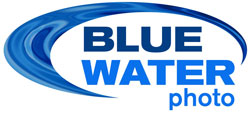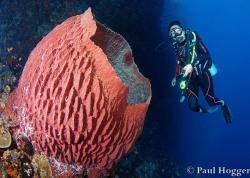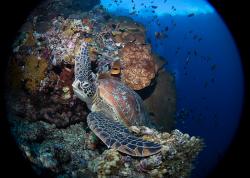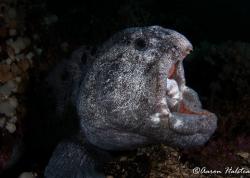Photo Essay: Port Hardy, British Columbia
Port Hardy, British Columbia Underwater Photo Essay
By Rand McMeins
Port Hardy is located at the north end of Vancouver Island, and is an underwater photography paradise. The waters off northern Vancouver Island feature amazing invertebrate life, wolf eels, and octopus. The dives also include walls covered with colorful anemones, a variety of sponges and starfish, and loads of fish including black rockfish, seals, and sea lions. Also, it is not uncommon to see killer whales on the surface.

Lions mane sea jelly & diver. Tokina 10-17mm FE lens, F4 @ 1/200th, ISO 200.
Dive sites visited
We did two dives at Race Rocks. This was on a day-boat out of Victoria, B.C. with Ogden Point Diver Centre. After diving there, we headed up to Port Hardy and did the balance of the diving there. The most well known site is Browning Wall. Without a doubt, the most beautiful wall I've ever dove anywhere. Wall-to-wall color, critters, and growth.
Underwater temps and visibility
The dives at Race Rocks out of Victoria were my first at that location. The boat Captain said that the vis was just about as good as it gets the day we dove. I'd put it around 30-40'. Perhaps to 60' or more in Port Hardy. Water temps for both locations were in the mid 50's, but his can change quickly with an upwelling which we had on a few dives in Port Hardy.

Kelp greenling, anemones and orange peel nudibranch. Tokina 10-17mm FE lens, F6.3 @ 1/125th, ISO 200.

Wolf eel. Nikon 105mm macro lens, F9 @ 1/200th, ISO 200.
Underwater photography opportunities
Race Rocks was a wide-angle dive for me. The Stellar sea lions are the main attraction and they have some big ones. Some were well over 2,000 lbs. I was first in on the first dive and was surrounded by about 100 of them for the first few minutes. They like to come from behind and bump your head. A high pucker-factor for sure. The topography underwater is sparse. It featured some big boulders, but not much to see for growth so, other than some Seastars and Puget Sound king crab, not much. Both dives were with the sea lions, so no real opportunity to go explore.
Port Hardy is great for both macro and wide-angle. A bounty of macro subjects. Shrimp, Nudis, Dorids, Skeleton shrimp, Gunnels, free swimming snails, and sea fleas. And of course the high dollar targets, Warbonetts, both decorated and Mosshead.
And of course wide-angle. The walls are so beautiful. Every color imaginable, and so dense that there's no open space to place a finger to steady yourself. Subjects include wolf eels, Great Pacific Octopus, Lions' mane jellyfish, anemones as big as a dinner plate, sponges, and soft corals. There are huge Orange peel nudibranchs, some close to 2 feet long. Read about how to photograph nudibranchs. But be careful if you see a giant pacific octopus, the octopus may steal your camera rig.
There are also kelp beds that serve as cover for Black Rockfish. The kelp is very photogenic on a sunny day.
The fish life is a bit less as compared to the Caribbean for instance. But what's there makes for great photo ops. Small sculpins have the ability to change color to match their surroundings. Making for an endless variety of coloration on this single subject.
A favorite of photographers is the Red Irish Lord. A very co-operative subject apparently having high confidence in its ability to blend in. Their eyes are a special treat when lit properly, since they are flecked with gold-colored bits.
The very odd-shaped Grunt sculpin with a head that resembles a barnacle and a tail that looks like the feeding arm, as well as Ling Cod and Cabezon are favorites.
Orange peel nudibranch. Tokina 10-17mm FE lens, F4 @ 1/125th, ISO 200.

Gunnel. Nikon 105mm macro lens, F8 @ 1/200th, ISO 200.
Overall impressions of underwater photography at Port Hardy
The diving in Port Hardy I'd rate as world class. If you haven't dove there yet, it's got to be on anyone's bucket list that does temperate diving. The kelp beds in California offer some beautiful scenery and would be my second choice, but even then, it's not even close to the diversity of color and critters in Port Hardy.
Plus, the topside opportunities are ample. Whales, dolphins, sea lions, orcas, otters, deer, bears, and the grand bald eagles. We saw eagles in the trees on almost every dive.
Accomodations at Port Hardy
We dove with Dan Ferris in Port Hardy on the Mamro. We did three dives a day. It doesn't sound like that would fill a day but somehow, it usually did and the cold water takes its toll as well.
And yes, the timing of the dives is crucial, especially for underwater photographers. One of the reasons we've continued to dive with Dan Ferris on the Mamro. He's excellent at giving us that slack window.
The currents in the area can be very strong, ranging from 1 knot all the way to 15+ knots. Some of the best diving in the Port Hardy area can only be done at precise slack tide, and some are only for expert divers. These strong currents are due to the large tidal swings, and a narrow channel between Vancouver Island and the Lower Mainland. ~Editor

Nudibranch amongst the plumose anemones. Tokina 10-17mm FE lens, F3.5 @ 1/125th, ISO 200.

B&W sea flea. Nikon 105mm macro lens & SubSee +10 diopter, F13 @ 1/200th, ISO 200.
Underwater photography equipment
For this adventure, Rand used a Nikon D2x camera in a Subal D2 underwater housing, and 2 Inon Z220 strobes. All the wide-angle, except for the sea lions and topside shots (15mm for those) were with a Tokina 10-17 FE zoom behind the Zen mini dome. Macro shots were captured with the Nikon 105mm macro lens, the supermacro shots were taken utilizing the Nikon 105mm macro lens along with the Subsee +10 diopter.

Nudibranch confronts hermit crab. F20 @ 1/200th, ISO 200.
Orca pod. 15mm Fisheye lens, F8 @ 1/200th, ISO 200

Anemones. Tokina 10-17mm FE lens, F3.5 @ 1/125th, ISO 200.
Underwater photography tips
The biggest challenge shooting wide-angle in cold water is the extra gear and weight you must wear. Turning over on your back to shoot up into the water column is no easy feat. Sometimes I feel like a cockroach trying to flip over, and I'm sure seeing my legs flailing and arms wind milling is not pretty.
The other issues are lack of ambient light at depth, and the amount of crud in the water. The light issue sometimes requires bumping up the ISO. Cameras that can do that and maintain low noise are a real asset.
My D2x is not one of them, so I kept my max ISO at 200. The backscatter is an issue that can cause the best image of your life to hit the trash bin.
Two of the techniques that I've found pretty effective:
- Shoot more reef than you normally would. Concentrate on lighting on a small area then allowing the light to fall off with just a touch of open water at the top of the frame can keep scatter to a minimum. Shooting with strobes into open water invites a really horrible result. By keeping your strobes tight or even just using one strobe will help as well. Try lighting the foreground subject from over the top of the dome port or off to one side, as this will help eliminate backscatter. You might also end up with a more pleasing result with using just a single strobe.
- Get as close as possible to the subject and light only the subject. I really enjoy using the Tokina 10-17mm fisheye lens with a Zen mini dome. This set-up allows me to get right on top of the subject and keep my strobes tight.

Black rockfish and Bull kelp. Tokina 10-17mm FE lens with ambient light, F5.6 @ 1/15th, ISO 200.

Sea flea on orange seapen. Nikon 105mm with Subsee +10 diopter, F16 @ 1/200th, ISO 200.

Stellar sea lion. F2.8 @ 1/250th, ISO 200.
About the author
Rand McMeins is, at present, a PADI Dive master. Certified to dive in September of 2001, he bought his first digital camera in 2002; an Olympus C4040z 4 MP digital camera, housed in Light & Motion's Tetra housing with a single Sea & Sea YS90dx strobe. As of Spring of 2005, he's shooting with a Nikon D2X in a Subal underwater housing.
Rand lives and dives in the Northwest, which has provided him with ample opportunity to practice and improve his underwater photography skills. Although he enjoys a nice dive in warm water whenever the opportunity presents itself, the cold, green waters of the Pacific present some of the most beautiful and weird creatures one could ever hope to capture on digital media!
Please visit Rand's website at Greenwater Images.
Further reading
Support the Underwater Photography Guide
Please support the Underwater Photography Guide by purchasing your underwater photography gear through our sister site, Bluewater Photo & Video. Click, or call them at (310) 633-5052 for expert advice!
RECOMMENDED ARTICLES
SUPPORT THE UNDERWATER PHOTOGRAPHY GUIDE:
The Best Service & Prices on u/w Photo Gear
 Visit Bluewater Photo & Video for all your underwater photography and video gear. Click, or call the team at (310) 633-5052 for expert advice!
Visit Bluewater Photo & Video for all your underwater photography and video gear. Click, or call the team at (310) 633-5052 for expert advice!
The Best Pricing, Service & Expert Advice to Book your Dive Trips
 Bluewater Travel is your full-service scuba travel agency. Let our expert advisers plan and book your next dive vacation. Run by divers, for divers.
Bluewater Travel is your full-service scuba travel agency. Let our expert advisers plan and book your next dive vacation. Run by divers, for divers.


































